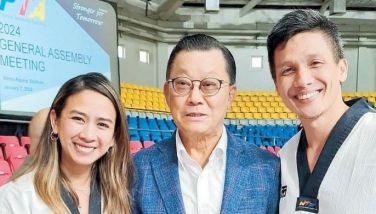First gongs, bamboo festival/An impressive neophyte ‘diva’/ Kurodas off to greener turf
Tunog-tugan, the first International Gongs and Bamboo Music Festival, was presented on its second phase at Fleur de-Lis auditorium.
Ramon P. Santos writes: “The Festival is a celebration of a heritage of countless expressions in human conversation and artistic creation through the music(s) of gongs and bamboo existing for thousands of years in Asia, representing a common patrimony that has sustained a way of life replete with spiritual purpose, aesthetic significance, social sharing and human affection.â€
Several Filipino groups and a group each from many Asian countries performed. Dr. Santos continues: “Their gongs and bamboo serve as living traditions to many human endeavors ‑ from rituals and prayers, birth, baptism, initiation, courtship, weddings, to planting and harvesting, feasts and celebrations, thanksgiving, games, wakes and funerals. These activities are all expressed with gongs and bamboo instruments.â€
I witnessed only four groups perform. Thai and Indonesian sounded Chinese, China being the oldest Asian civilization. Thai music and dances seemed very repetitive, approaching tedium. The Cordillera participants fascinated. In very colorful, traditional attire, that bared part of the men’s buttocks, the ensemble created lively rhythms on gongs, two women dancing in primeval, spirited fashion.
In a bit of drama, a maiden sitting as she sews, is courted by several men, each successively serenading her with an instrument. She rejects them. Finally, she responds to a suitor who plays on a nose flute, and a wedding is presumably in the offing.
Even more riveting was the Vietnam/Canada “Khac Chi Bamboo Music rendered by a world-acclaimed pair who proved the versatility of bamboo through their own incredibly ingenious, modern instruments. The woman produced music on a bamboo board, yet her hands were traveling to and fro an inch away from the board! She held another instrument which made music only if she blew on a small disc. Earlier, she played on an upright, triangular xylophone. The male musician demonstrated the use of several of his own fantastic instruments.
The Indonesians struck gongs and drums of varying shapes and sizes, with two women dancing to their energetic rhythms. The vibrant performers enjoined members of the audience to join them onstage to point up unity in diversity.
Sr. Anunciata Sta. Ana’s invitation took us back to our ancient roots grown unfamiliar or forgotten through the centuries.
* * *
The first public performance of soprano Gabriella Panlilio at the A. Yuchengco Opera Haus Centre was a most pleasant surprise. Daughter of Lito and Rosa Panlilio, grand daughter of Loleng Panlilio, and mentored by the eminent mezzo-soprano Clarissa Ocampo, Gabriella revealed persuasive potential and promise made more astounding because she is only 15!
Her widely-ranging program opened with Italian songs by Giovanni Paisello (1741-1861), a composer from Naples who was a rival of the better-known Rossini, and Marco Antonio (1620-1669). Gabriella switched to German for Brahms’ familiar exquisitely melodious Wiegenlied (lullaby) and the love song Vergebliches Standchen.
Faure’s French songs, Apres en Reve and Claire de Lune, were characterized by the composer’s restraint, refinement and expert workmanship. V. Williams’ Silent Noon and Linden Lea, typically inspired by English folk songs, were converted by his craft from personal to universal songs.
Gabriella’s last selection was Lucio San Pedro’s Sa Ugoy ng Duyan, followed by an encore in response to lusty applause. For the young, attractive singer arduous work is still ahead, but with persistence, her natural gifts — a luminous timber, firm and assured delivery and spontaneous expressivity — will lead to an auspicious future. One or two joyful songs, in consonance with Gabriella’s youth, would have added spice to the serious program. Ocampo is judiciously charting more public exposure for her neophyte “divaâ€.
* * *
We shall be missing Kumiko Kuroda’s informal musicales at which she played the recorder with friends, or accompanied singers on the piano. At one time, the eminent soprano Margarita Gomez sang.
Kumiko and her husband Haruhiko Kuroda, current ADB president, are returning to Japan because Prime Minister Shinzo Abe is eyeing Mr. Kuroda as the next Central Bank governor owing to his experience in international finance and monetary prescriptions.
- Latest
- Trending





























